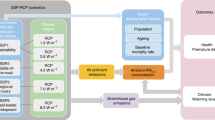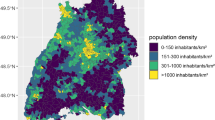Abstract
The impact of climate change on human and environmental health is of critical concern. Population exposures to air pollutants both indoors and outdoors are influenced by a wide range of air quality, meteorological, behavioral, and housing-related factors, many of which are also impacted by climate change. An integrated methodology for modeling changes in human exposures to tropospheric ozone (O3) owing to potential future changes in climate and demographics was implemented by linking existing modeling tools for climate, weather, air quality, population distribution, and human exposure. Human exposure results from the Air Pollutants Exposure Model (APEX) for 12 US cities show differences in daily maximum 8-h (DM8H) exposure patterns and levels by sex, age, and city for all scenarios. When climate is held constant and population demographics are varied, minimal difference in O3 exposures is predicted even with the most extreme demographic change scenario. In contrast, when population is held constant, we see evidence of substantial changes in O3 exposure for the most extreme change in climate. Similarly, we see increases in the percentage of the population in each city with at least one O3 exposure exceedance above 60 p.p.b and 70 p.p.b thresholds for future changes in climate. For these climate and population scenarios, the impact of projected changes in climate and air quality on human exposure to O3 are much larger than the impacts of changing demographics. These results indicate the potential for future changes in O3 exposure as a result of changes in climate that could impact human health.
This is a preview of subscription content, access via your institution
Access options
Subscribe to this journal
Receive 6 print issues and online access
$259.00 per year
only $43.17 per issue
Buy this article
- Purchase on Springer Link
- Instant access to full article PDF
Prices may be subject to local taxes which are calculated during checkout






Similar content being viewed by others
References
Zhang Y, Wang Y . Climate-driven ground-level ozone extreme in the fall over the Southeast United States. Proc Natl Acad Sci 2016; 113: 10025–10030.
Garcia-Menendez F, Saari RK, Monier E, Selin NE . U.S. air quality and health benefits from avoided climate change under greenhouse gas mitigation. Environ Sci Technol 2015; 49: 7580–7588.
Lin M, Fiore AM, Horowitz LW, Langford AO, Oltmans SJ, Tarasick D et al. Climate variability modulates western US ozone air quality in spring via deep stratospheric intrusions. Nat Commun 2015; 7105: 1–11.
Fann N, Nolte CG, Dolwick P, Spero TL, Brown AC, Phillips S et al. The geographic distribution and economic value of climate change-related ozone health impacts in the United States in 2030. J Air Waste Manag Assoc 2015; 65: 570–580.
Post ES, Grambsch A, Weaver C, Morefield P, Huang J, Leung L-Y et al. Variation in estimated ozone-related health impacts of climate change due to modeling choices and assumptions. Environ Health Perspect 2012; 120: 1559–1564.
Sun J, Fu J, Huang K, Gao Y . Estimation of future PM2.5- and ozone-related mortality over the continental United States in a changing climate: an application of high-resolution dynamical downscaling technique. J Air Waste Manag Assoc 2015; 65: 611–623.
Patz JA, Frumkin H, Holloway T, Vimont DJ, Haines A . Climate change: challenges and opportunities for global health. J Am Med Assoc 2014; 312: 1565–1580.
Bell ML, Goldberg R, Hogrefe C, Kinney PL, Knowlton K, Lynn B et al. Climate change, ambient ozone, and health in 50 US cities. Climatic Change 2007; 82: 61–76.
Pearce JL, Waller LA, Sarnat SE, Chang HH, Klein M, Mulholland JA et al. Characterizing the spatial distribution of multiple pollutants and populations at risk in Atlanta, Georgia. Spat Spatiotemporal Epidemiol 2016; 18: 13–23.
Wade KS, Mulholland JA, Marmur A, Russell AG, Hartsell B, Edgerton E et al. Effects of instrument precision and spatial variability on the assessment of the temporal variation of ambient air pollution in Atlanta, Georgia. J Air Waste Manag Assoc 2006; 56: 876–888.
Graham SE, McCurdy T . Developing meaningful cohorts for human exposuremodels. J Expo Sci Environ Epidemiol 2004; 14: 23–43.
Baxter LK, Burke J, Lunden M, Turpin BJ, Rich DQ, Thevenet-Morrison K et al. Influence of human activity patterns, particle composition, and residential air exchange rates on modeled distributions of PM2.5 exposure compared with central-site monitoring data. J Expo Sci Environ Epidemiol 2013; 23: 241–247.
Mudakavi JR . Principles and Practices of Air Pollution Control and Analysis. I K International Publishing House: New Delhi, India. 2010.
Breen MS, Schultz BD, Sohn MD, Long T, Langstaff J, Williams R et al. A review of air exchange rate models for air pollution exposure assessments. J Expo Sci Environ Epidemiol 2013; 24: 555–563.
Ilacqua V, Dawson J, Breen M, Singer S, Berg A . Effects of climate change on residential infiltration and air pollution exposure. J Expo Sci Environ Epidemiol 2015; 27: 16–23.
Isaacs K, Burke J, Smith L, Williams R . Identifying housing and meteorological conditions influencing residential air exchange rates in the DEARS and RIOPA studies: development of distributions for human exposure modeling. J Expo Sci Environ Epidemiol 2013; 23: 248–258.
U.S. EPAHealth Risk and Exposure Assessment for Ozone: Final Report (Contract No.: EPA-452/R-14-004a). U.S. Environmental Protection Agency, Office of Air Quality Planning and Standards: Research Triangle Park, NC, USA, 2014.
U.S. EPATotal Risk Integrated Methodology (TRIM) Air Pollutants Exposure Model Documentation (TRIM.Expo/APEX, Version 4.5), Volume I: User's Guide (EPA-452/B-12-001a). US EPA Office of Air Quality Planning and Standards: Research Triangle Park, NC, USA, 2012.
U.S. EPATotal Risk Integrated Methodology (TRIM) Air Pollutants Exposure Model Documentation (TRIM.Expo/APEX, Version 4.5), Volume II: Technical Support Document (EPA-452/B-12-001b). US EPA Office of Air Quality Planning and Standards: Research Triangle Park, NC, USA, 2012.
USGCRP, Fann N, Brennan T, Dolwick P, Gamble JL, Ilacqua V, Kolb Let al. Chapter 3: Air Quality Impacts.The Impacts of Climate Change on Human Health in the United States: A Scientific Assessment. U.S. Global Change Research Program: Washington, DC, USA. 2016; pp 69-98. http://dx.doi.org/10.7930/JOGQ6VP6.
Code of Federal Regulations. Title 40: Protection of the Environment. Chapter I Section 50.19: National primary and secondary ambient air quality standards for ozone. 2015.
Gent PR, Danabasoglu G, Donner LJ, Holland MM, Hunke EC, Jayne SR et al. The Community Climate System Model version 4. J Climate 2011; 24: 4973–4991.
Taylor KE, Stouffer RJ, Meehl GA . An overview of CMIP5 and the experimentdesign. Am Meteorol Soc 2012; 93: 485–498.
Skamarock WC, Klemp JB . A time-split nonhydrostatic atmospheric model for weather research and forecasting applications. J Comput Phys 2008; 227: 3465–3485.
Otte TL, Nolte CG, Otte MJ, Bowden JH . Does nudging squelch the extremes in regional climate modeling? J Climate 2012; 25: 7046–7066.
Spero TL, Nolte CG, Bowden JH, Mallard MS, Herwehe JA . The impact of incongruous lake temperatures on regional climate extremes downscaled from the CMIP5 archive using the WRF model. J Climate 2016; 29: 839–853.
van Vuuren DP, Edmonds J, Kainuma M, Riahi K, Thomson A, Hibbard K et al. The representative concentration pathways: an overview. Climatic Change 2011; 109: 5–31.
Byun DW, Schere KL . Review of the governing equations, computational algorithms, and other components of the Models-3 Community Multiscale Air Quality (CMAQ) modeling system. Appl Mech Rev 2006; 59: 51–77.
U.S. EPA ICLUS Tools and Datasets (Version 1.3.2). U.S. Environmental Protection Agency: Washington, DC, USA. 2010.
U.S. EPA Land-Use Scenarios: National-Scale Housing-Density Scenarios Consistent with Climate Change Storylines. U.S. Environmental Protection Agency, National Center for Environmental Assessment: Washington, DC, USA. 2009.
U.S. EPA. ICLUS Tools and Datasets (Version 1.3.2)2013 Available from https://cfpub.epa.gov/ncea/global/recordisplay.cfm?deid=257306.
McCurdy T, Glen G, Smith L, Lakkadi Y . The National Exposure Research Laboratory's Consolidated Human Activity Database. J Expo Anal Environ Epidemiol 2000; 10 ((Pt 1)): 566–578.
U.S. EPA. CHAD User's Guide: Extracting Human Activity Information from CHAD on the PC. U.S. Environmental Protection Agency, National Exposure Research Laboratory Contract No.: 3092132000.
U.S. EPA Integrated Science Assessment for Ozone and Related Photochemical Oxidants. National Center for Environmental Assessment-RTP Division, Office of Research and Development, U.S. Environmental Protection Agency: Research Triangle Park, NC, USA. 2013. Report number EPA/600/R-10/076F.
U.S. EPA Policy Assessment for the Review of the Ozone National Ambient Air Quality Standards. U.S. Environmental Protection Agency, Office of Air Quality Planning and Standards: Research Triangle Park, NC, USA. 2014. Report number EPA-452/R-14-006.
Echols SL, MacIntosh DL, Hammerstrom KA, Ryan PB . Temporal variability of microenvironmental time budgets in Maryland. J Expo Anal Environ Epidemiol 1999; 9: 502–512.
Xue J, McCurdy T, Spengler J, Ozkaynak H . Understanding variability in time spent in selected locations for 7-12 year old children. J Expo Anal Environ Epidemiol 2004; 14: 222–233.
Baxter LK, Stallings C, Smith L, Burke J . Probabilistic estimation of residential air exchange rates for population-based human exposure modeling. J Expo Sci Environ Epidemiol 2016 (doi: 10.1038/es.2016.49; e-pub ahead of print).
Neidell M . Information, avoidance behavior, and health: the effect of ozone on asthma hospitalizations. J Hum Resour 2009; 44: 450–478.
Acknowledgements
The CESM data were obtained from the Earth System Grid (http://www.earthsystemgrid.org). The WRF Model was obtained from the National Center for Atmospheric Research (http://www.wrf-model.org). Valuable discussions with Thomas McCurdy (US EPA, now retired) and Lisa Baxter (US EPA) contributed toward the final research directions and outcomes reported here. Janet Burke and Peter Egeghy from the US EPA provided technical feedback on this paper. The US EPA through its Office of Research and Development funded and managed the research described here. It has been subjected to the Agency’s administrative review and approved for publication. The views expressed in this paper are those of the authors and do not necessarily represent the view or policies of the US EPA.
Author information
Authors and Affiliations
Corresponding author
Ethics declarations
Competing interests
The authors declare no conflict of interest.
Additional information
Supplementary Information accompanies the paper on the Journal of Exposure Science and Environmental Epidemiology website
Supplementary information
Rights and permissions
About this article
Cite this article
Dionisio, K., Nolte, C., Spero, T. et al. Characterizing the impact of projected changes in climate and air quality on human exposures to ozone. J Expo Sci Environ Epidemiol 27, 260–270 (2017). https://doi.org/10.1038/jes.2016.81
Received:
Accepted:
Published:
Issue Date:
DOI: https://doi.org/10.1038/jes.2016.81
Keywords
This article is cited by
-
Ozone exposure upregulates the expression of host susceptibility protein TMPRSS2 to SARS-CoV-2
Scientific Reports (2022)
-
Biogeochemical transformation of greenhouse gas emissions from terrestrial to atmospheric environment and potential feedback to climate forcing
Environmental Science and Pollution Research (2020)



